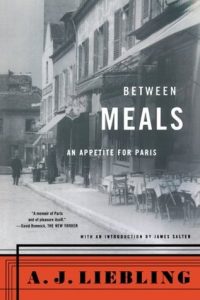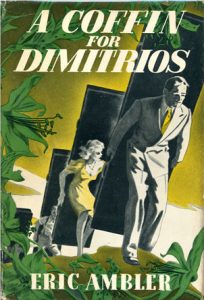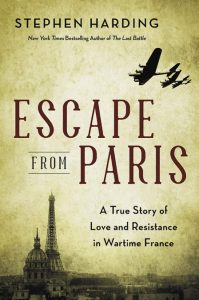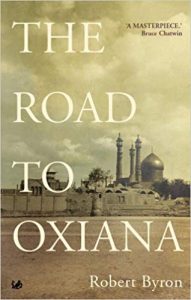
Alan Furst’s Under Occupation is published today. He shares five gems of the interwar period.

Between Meals by A.J. Liebling
A lovely book about food and wine and Paris in the 1920s by a writer with a New Yorker magazine style.
Jane Ciabattari: This is one of my favorites, as well. And what’s not to like about this delectable paragraph:
In the restaurant on the Rue Saint-Augustin, M. Mirande would dazzle his juniors, French and American, by dispatching a lunch of raw Bayonne ham and fresh figs, a hot sausage in crust, spindles of filleted pike in a rich rose sauce Nantua, a leg of lamb larded with anchovies, artichokes on a pedestal of foie gras, and four or five kinds of cheese, with a good bottle of Bordeaux and one of champagne, after which he would call for the Armagnac and remind Madame to have ready for dinner the larks and ortolans she had promised him, with a few langoustes and a turbot—and, of course, a fine civet made from the marcassin, or young wild boar, that the lover of the leading lady in his current production had sent up from his estate in the Sologne. “And while I think of it,” I once heard him say, “we haven’t had any woodcock for days, or truffles baked in the ashes, and the cellar is becoming a disgrace—no more ’34s and hardly any ’37s. Last week, I had to offer my publisher a bottle that was far too good for him, simply because there was nothing between the insulting and the superlative.”
How did Liebling’s portrait of Parisian life influence your work on a spy novel set during the Occupation?
Alan Furst: Even though Liebling is an American writing about French life and ways, he paints such a vivid portrait of sophisticated life in Paris. The primary characters in my book are also sophisticated people living in Paris, who found the occupation particularly hard because they were very much independent, as a sophisticated kind of person in Paris would have been at the time.

A Coffin for Dimitrios by Eric Ambler
Intrigue in Greece and Turkey.
JC: The 1930s Europe Ambler portrays is bubbling with danger, in a universe ready to explode. Like Ambler’s, your narrator is a detective novelist. What are the advantages of taking that point of view? And the disadvantages?
AF: In my mind, Eric Ambler is the writer from the 30s who understood fascism and its horrors as well as or better than anyone writing at the time. When you’re reading Ambler, you’re reading someone who really knows what’s going on, and you cannot put it down. What I like the most is his geographical sense. He really understood the political dynamics of Greece and Turkey and all of Southeastern Europe at the time, and it informs his work.

Escape from Paris by Stephen Harding
A terrific love and World War II story about Paris.
JC: A downed American bomber crew lost in the French countryside find their way to a hidden location at the Hôtel des Invalides in Nazi-occupied Paris where they are sheltered by the Morin family, members of the French Resistance, at much risk. Harding draws from case files relating to French citizens who assisted American airmen for his plot. What research from that era did you turn to in working on Under Occupation?
AF: The Nazi occupation was the most important event in Europe. It subsumed everything that went on and it has to be remembered. Paris is the heart of Europe and is particularly the heart of my Europe in the book.
Last Hope Island by Lynne Olson
Lynne Olson is very near the top of my list of my favorite writers about German Occupation of France.
JC: What distinguishes Last Hope Island?
AF: What distinguishes Last Hope Island is that it is a much more general view. Lynne Olson is one of best and most dynamic historians I have ever read. She is fabulous. I don’t know why or how, but she is the most fabulous writer and she has the most incredible and penetrating understanding of what went on during this period. Let’s say that Last Hope Island is much more of a political overview of the war years and how it affected London.

The Road to Oxiana by Robert Byron
Set in 1933, about archeology at the border between Afghanistan and Russia.
JC: This is an exemplary book of travel writing by a contemporary of Evelyn Waugh who died in 1941 while reporting during World War II. As Paul Fussell put it, “The Road to Oxiana is to travel writing what Ulysses is to the novel between the wars, and what The Waste Land is to poetry.” Byron is witty, and clear, in describing the architecture of a part of the world he visited in the 1930s, tracking the genesis of Islamic architecture. “As passes go, the Khyber is invitingly mild,” he writes. “It is this which makes it the theatre of such stupendous works.” What elements of the book most impress you? The tone? The language? The range of travel?
AF: Robert Byron is one of those people who was smarter than anyone around him. I believe he was born gifted, and I believe that he is also neglected. The Road to Oxiana is not really about 1933 archeology. It is about the nature of life in far away and exotic places, and at least I found it irresistibly seductive. It really is.

